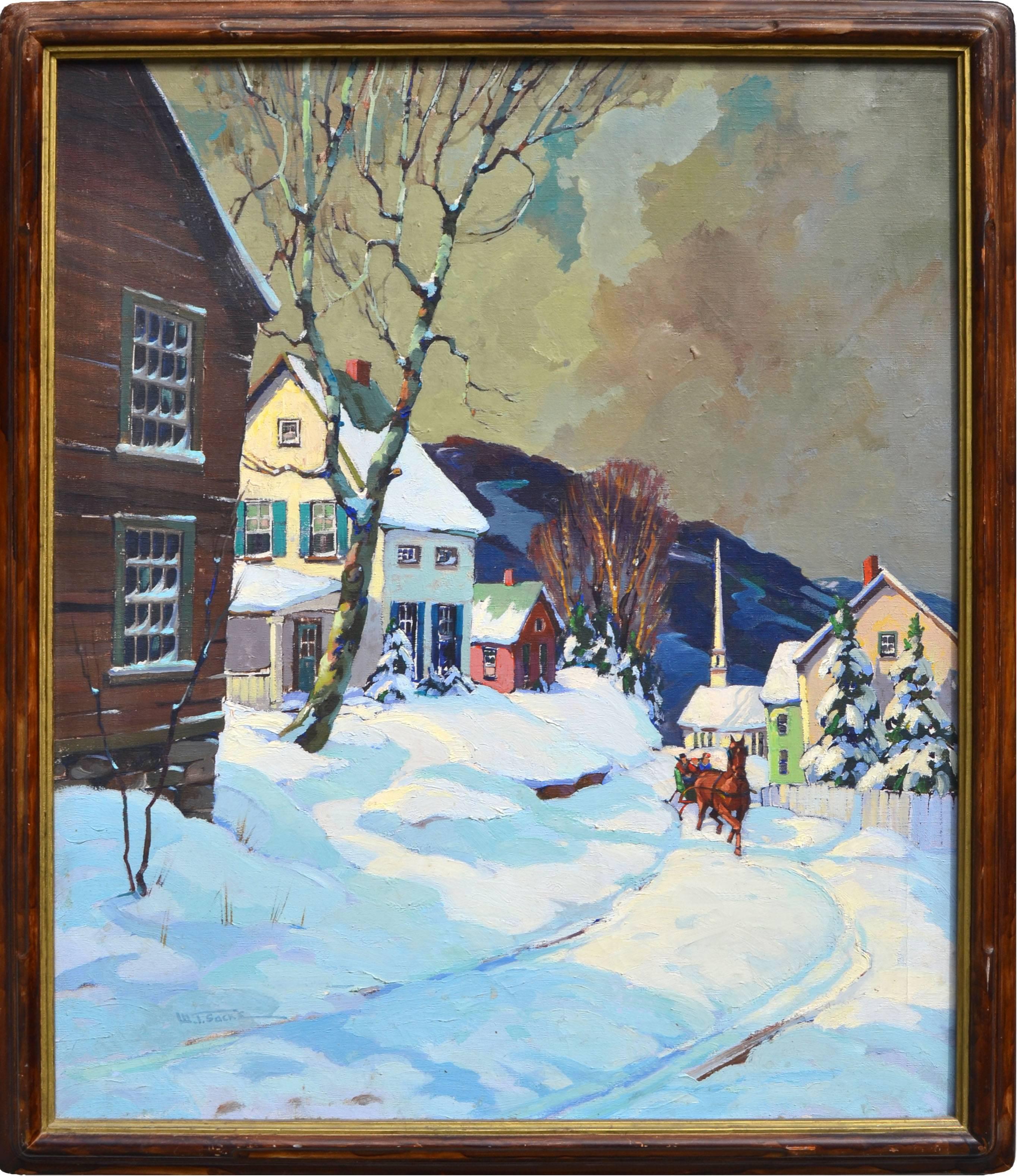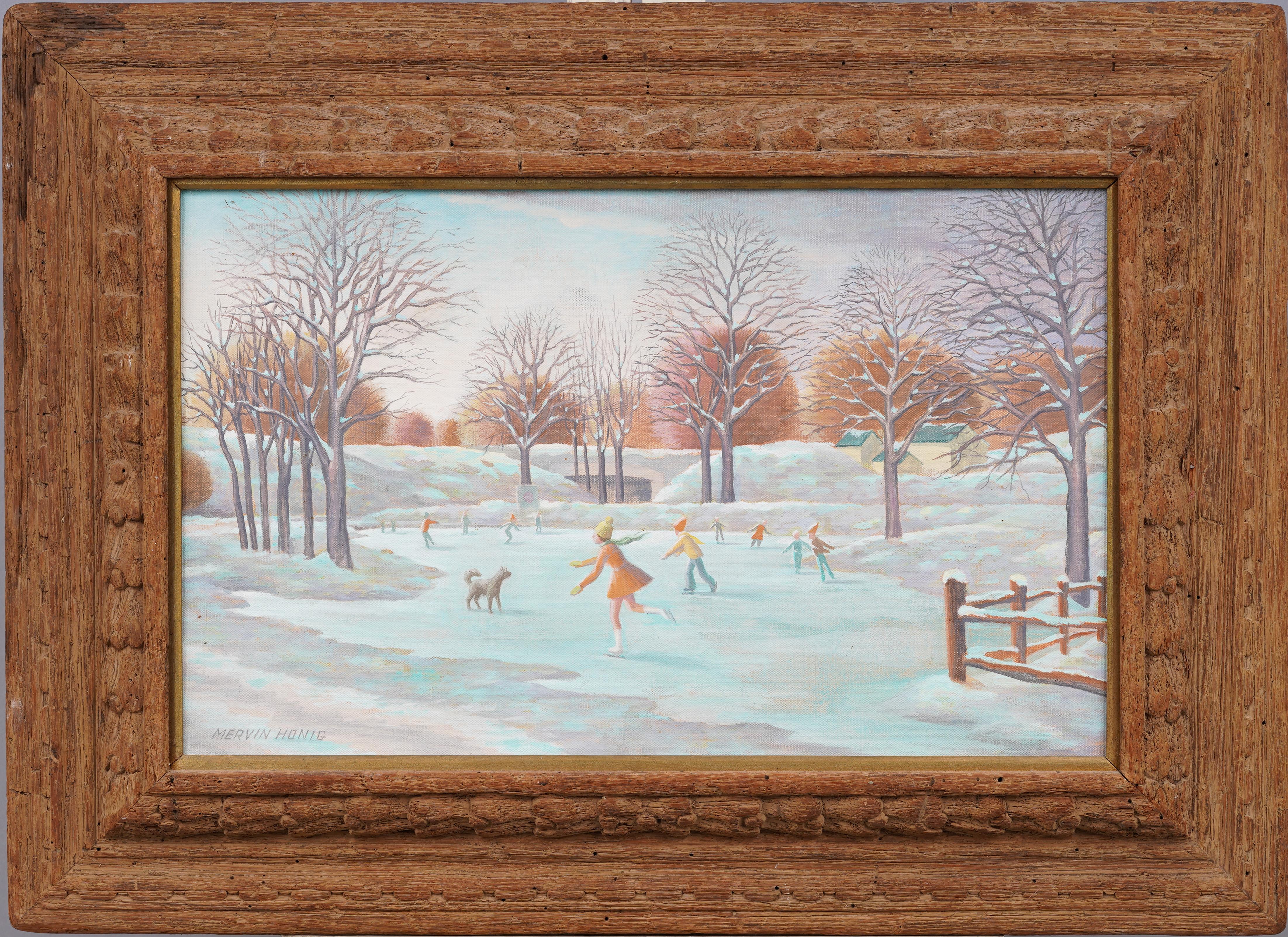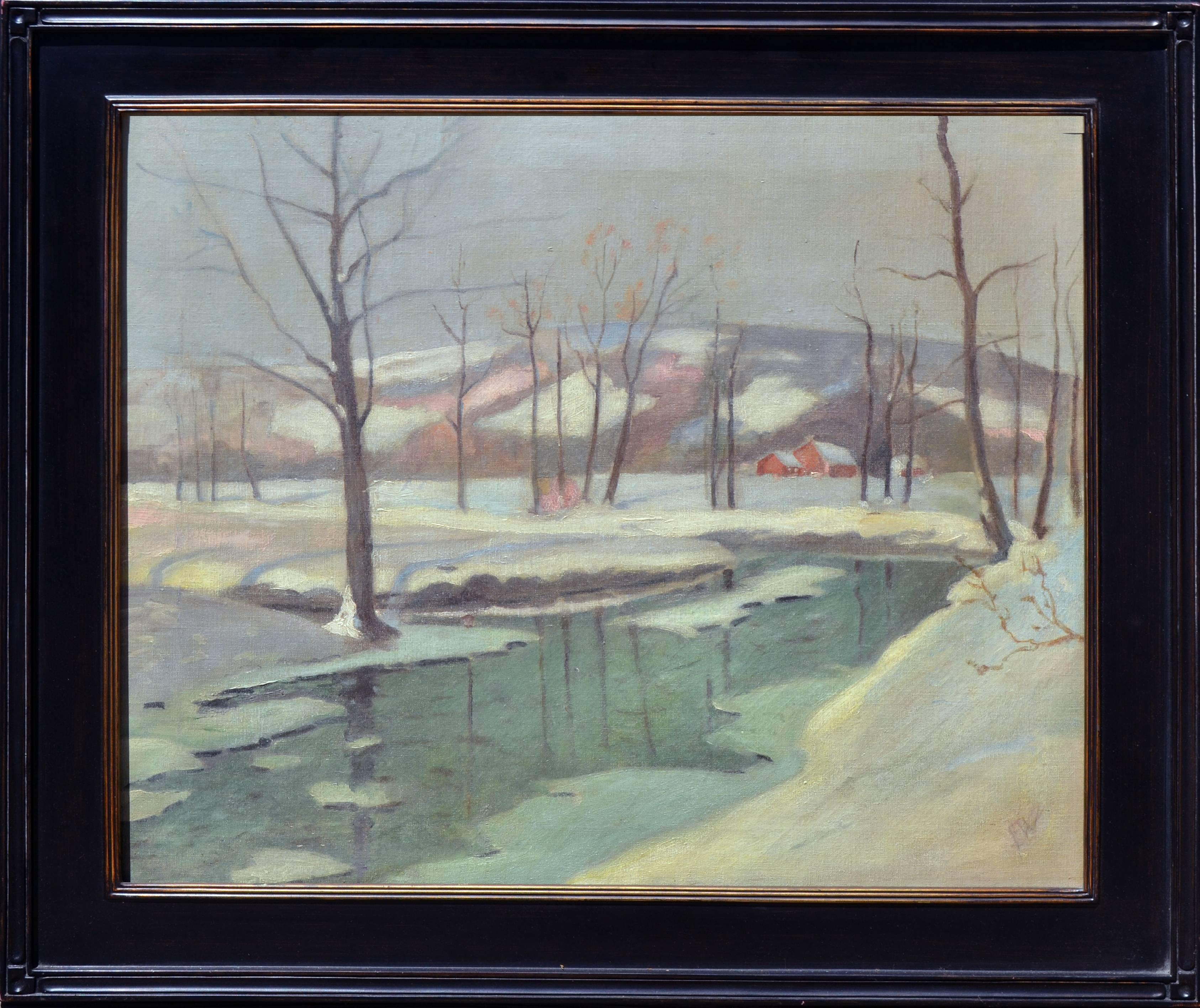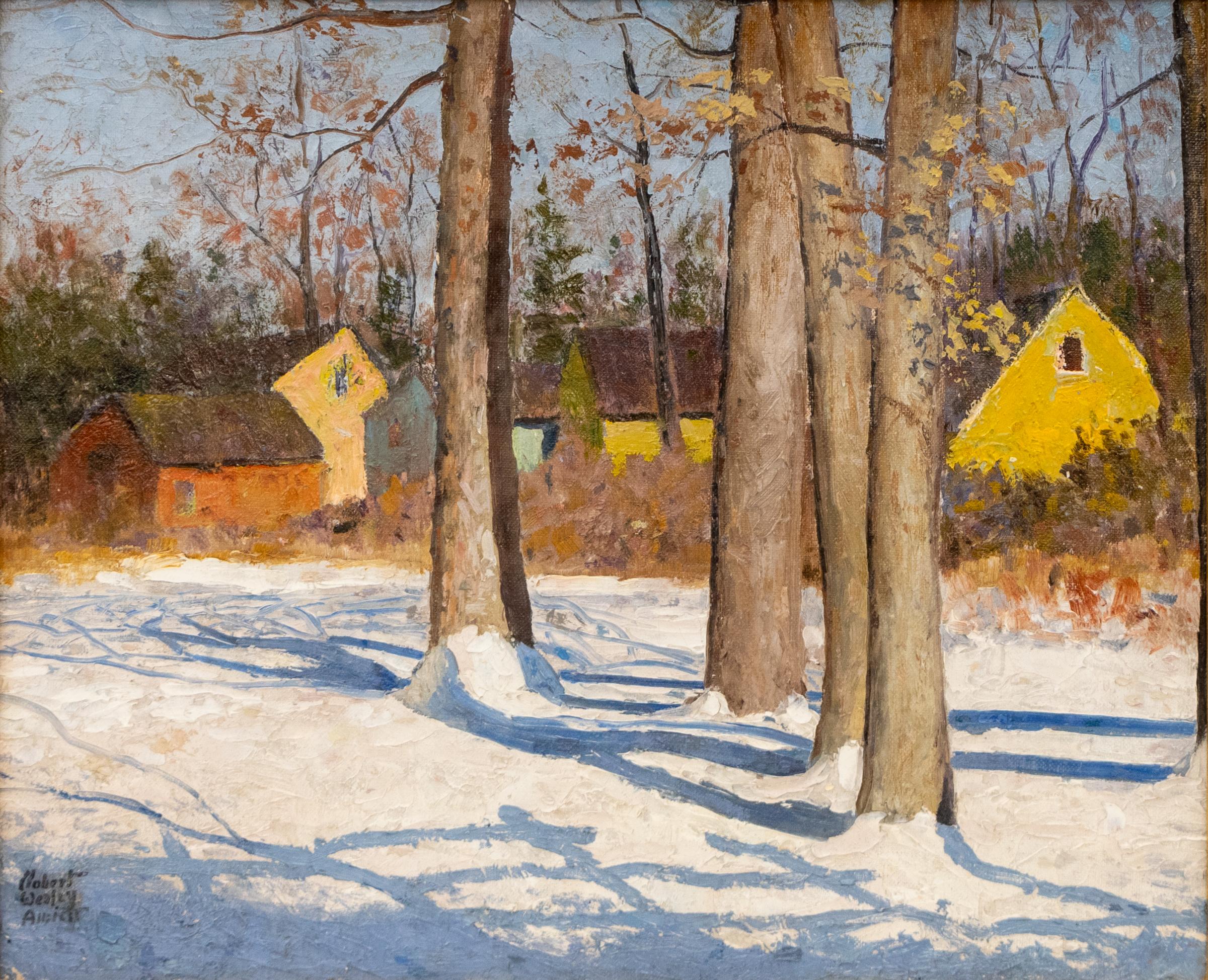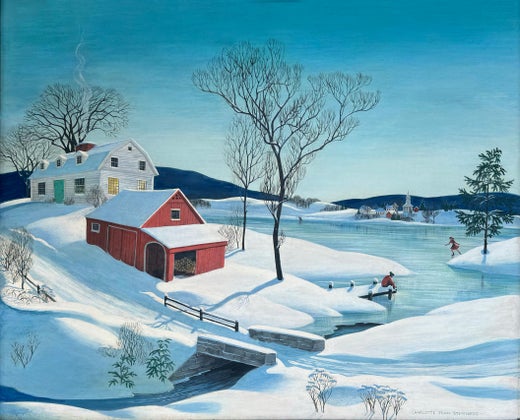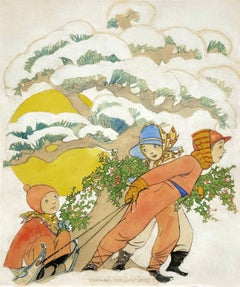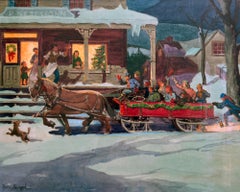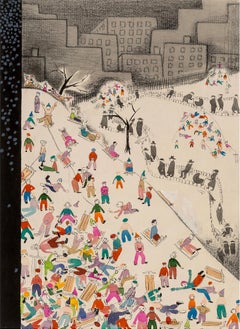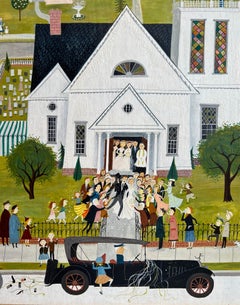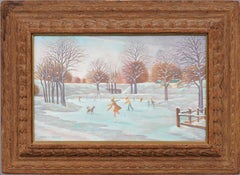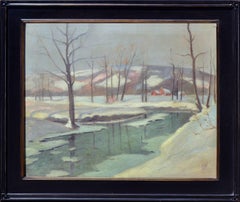Items Similar to Americana Winter Scene Ice Skaters Mid-Century- Norman Rockwell America
Want more images or videos?
Request additional images or videos from the seller
1 of 14
Charlotte SternbergAmericana Winter Scene Ice Skaters Mid-Century- Norman Rockwell America1950
1950
$6,500
£4,962.72
€5,734.38
CA$9,124.77
A$10,170.51
CHF 5,336.12
MX$124,198.46
NOK 67,566.83
SEK 63,860.93
DKK 42,798.17
About the Item
This charming rural winter scene of ice skaters fully displays Norman Rockwell's America, but it was painted by female artist Charlotte Joan Sternberg. She combines the mid-century Americana subject matter of Norman Rockwell with her highly feminine style of showing an expansive vista populated by carefully and precisely rendered small figures. The work was executed in egg tempera on masonite. Signed lower right: Charlotte Joan Sternberg. Signed and dated on verso.
The painting looks better in person. The uploaded video on 1stDibs is coming up a bit off color. Refer to the still images for more accurate color Framed size 24.75 x 20.5
Sternberg was born in Meriden, Connecticut in 1920. Her parents encouraged her interest in art. She attended Yale University and received a degree in fine art in 1942. While at school Charlotte hung out with her Yale friends at the restaurant, George and Harry's, north of the New Haven green. She was there when the news of the attack on Pearl Harbor arrived at Yale. She described the chaos of everyone yelling and running around. The war colored the experiences of the students including Charlotte. She painted portraits of injured and ill soldiers during World War II. She painted a portrait for Dwight Eisenhower during his presidency. It was also during this time that she discovered egg tempera. Egg tempera was enjoying a small revival at Yale. Professors such as Louis York and Daniel V. Thompson (author of The Practice of Tempera Painting) had rediscovered ancient techniques that had not been widely used since the Renaissance. This became her preferred medium for her paintings.
Personal life
Textron fabrics ad, painted by C. J. Sternberg (1948)
In 1953 she married Arthur Koch and they had a daughter - Carla Sternberg Koch.
Career and later life
She resided in New England and found inspiration from the region for her work. While she primarily painted portraits in her early career, she is most recognized for her landscapes. She painted farms and small American towns. Egg tempera was her preferred medium.[1] Charlotte became a commercial illustrator. She worked for companies such as J. Walter Thompson, the advertising agency, creating artwork for Esso (later Exxon), Textron, and Lederle Pharmaceuticals. In 1945 she became involved with Associated American Artists (AAA). Many of her snow scenes of New England were printed on Christmas cards over the next 50 years. Sternberg also designed a textile print that was marketed by AAA and produced by M. Lowenstein & Sons as part of the Signature Fabrics series.[4] Along with the portrait of Eisenhower she was also commissioned to paint Gov. John Lodge of Connecticut in the 60's. Her artwork was also exhibited in one-woman shows at the New Britain Museum of American Art in Connecticut and the Bennington Museum in Vermont and is in many private collections.Her work appeared on magazine covers, including Collier's and Country Gentleman
From 1970-1984, she served on the faculty of the Paier College of Art in Hamden, Connecticut, where she taught rendering, perspective, creative painting, and egg tempera in the interior design, illustration, and fine art departments. In 1980, she was inducted into the Meriden, Connecticut Hall of Fame. There is one example of Sternberg's work in the Cooper Hewitt Smithsonian Design Museum's collection: Textile, Snowflakes, 1952-1957.
From: Wikipedia
- Creator:Charlotte Sternberg (1920 - 2003, American)
- Creation Year:1950
- Dimensions:Height: 15.75 in (40.01 cm)Width: 19.5 in (49.53 cm)
- Medium:
- Movement & Style:
- Period:
- Condition:Scattered light foxing is visible only on close inspection. Frame rubbing on the extreme perimeter and mostly covered by the frames rabbet. Some possible inpainting, Overall good condition for a painting 75 years old.
- Gallery Location:Miami, FL
- Reference Number:1stDibs: LU385316286252
Charlotte Sternberg
Charlotte Joan Sternberg was born in Meriden, Connecticut in 1920. Early on, she became interested in art, and her parents encouraged her efforts. She attended public schools in the area, as well as taking art classes at the technical school. Afterwards, she attended the Yale School of Art. Her fellow classmates included Rudolph Zallinger, who executed the dinosaur mural at the Peabody Museum in New Haven; Jean Day Zallinger, renowned book illustrator; and Edward Paier, founder of the Paier College of Art. It was there that she became interested in egg tempera, and most of her well-known artwork was done in this medium. She was one of a number of Yale artists who revived this medium.(She did not work professionally in oils, although she sometimes used gouache or watercolor.) She went on to a long career in commercial illustration. She worked extensively for J.Walter Thompson, doing advertising art for such companies as Esso (later Exxon), Textron, and Lederle pharmaceuticals. While she did a variety of subjects, she was best known for her Americana themes, particularly snow scenes of historic New England. Many of these pieces were published as Christmas cards for American Artists Group. She also taught for many years at the Paier College of Art. She also did a number of limited edition prints for Greenwich Workshop. Her art is used on such items as tapestry pillows, puzzles, and decorative flags. She was commissioned to do several portraits, including those of Gov.John Lodge of Connecticut and President Dwight D. Eisenhower. Her artwork has been exhibited at the New Britain Museum of American Art in Connecticut and the Bennington Museum in Vermont. She lived in Connecticut throughout her life, and passed away in 2003.

About the Seller
4.9
Gold Seller
Premium sellers maintaining a 4.3+ rating and 24-hour response times
Established in 2005
1stDibs seller since 2016
115 sales on 1stDibs
Typical response time: 1 hour
- ShippingRetrieving quote...Shipping from: Miami, FL
- Return Policy
Authenticity Guarantee
In the unlikely event there’s an issue with an item’s authenticity, contact us within 1 year for a full refund. DetailsMoney-Back Guarantee
If your item is not as described, is damaged in transit, or does not arrive, contact us within 7 days for a full refund. Details24-Hour Cancellation
You have a 24-hour grace period in which to reconsider your purchase, with no questions asked.Vetted Professional Sellers
Our world-class sellers must adhere to strict standards for service and quality, maintaining the integrity of our listings.Price-Match Guarantee
If you find that a seller listed the same item for a lower price elsewhere, we’ll match it.Trusted Global Delivery
Our best-in-class carrier network provides specialized shipping options worldwide, including custom delivery.More From This Seller
View AllWomen's World Magazine Cover Illustration , Children Sledding
By Maginel Wright Enright Barney
Located in Miami, FL
Children Sledding, Women's World Magazine Cover, December 1939
Signed lower center image
watercolor, gouache, pencil, and wash on paper
Category
1930s American Modern Figurative Drawings and Watercolors
Materials
Gouache
Americana, Horse Drawn Sled Christmas Celebration with Barking Dog
Located in Miami, FL
Good wholesome mid-century Americana is on full display in the joyous illustration that depicts a red horsedrawn sled of merrymaking folks being rreated at an inn. Signed lower left
...
Category
1940s American Impressionist Figurative Paintings
Materials
Watercolor, Board
Children Snow Sledding in Central Park - New Yorker Cover Study
Located in Miami, FL
Hungarian/American artist/illustrator depicts a charming scene of sledding in the snow in Central Park. The work is abstract in its design as it's functional in its narrative - Unpublished New Yorker...
Category
1940s Modern Figurative Drawings and Watercolors
Materials
Charcoal, Ink, Watercolor, Gouache, Pencil
Wedding Day - Norman Rockwell Americana - Female Illustrator
By Lorraine Fox
Located in Miami, FL
Recently, women artists have been soaring in price to millions of dollars. In many cases, many of these women were quite obscure. For example, recently acknowledged Gertrude Abercrombie, a naive surrealist artist, has recently seen her paintings rise to the area of $400K. Lorraine Fox, who is a consummate female artist/ illustrator whose work rivals any of the recently anointed female stars is still an unknown quantity. She has exhibited at the Brooklyn Museum and is in the collection of the Smithsonian Archives of American Art, and she is a member of the Famous Artists School in Westport, Connecticut along with Norman Rockwell, Today she is relatively unknown and completely off the radar of the so-called art establishment. Wedding Day is a wonderful example of her mid-century, somewhat naive style. The work is signed lower right and was exhibited at the Brandywine River...
Category
1940s Modern Figurative Paintings
Materials
Oil, Board
Landscape in Winter
Located in Miami, FL
At a time when Abstract Expressionism was raging, realist painterJohn Atherton nods his head to the movement with a semi-abstract work. Meticulously rendered and carefully thought o...
Category
1950s Abstract Geometric Landscape Paintings
Materials
Oil
Depression Era New York City - Journey Back in Time - American Scene Painting
By Arnold Friedman
Located in Miami, FL
This is a painting about a man who travels back into the past and engages with a different stage in his life.
Arnold Friedman worked at the New York City Post Office for four decades...
Category
1930s American Realist Figurative Paintings
Materials
Oil, Wood Panel
You May Also Like
Stowe Vermont Village Sleigh Ride, Mid Century Winter Figurative Landscape
By Walter Thomas Sacks
Located in Soquel, CA
Stowe Vermont Village Sleigh Ride - Mid Century Winter Figurative Landscape
A bright, crisp morning and a sleigh ride through new snow in Stowe, Vermont...
Category
1940s Post-War Landscape Paintings
Materials
Canvas, Oil
Antique American School Modernist WPA Winter Ice Skating Framed Oil Painting
Located in Buffalo, NY
Impressive American modernist winter landscape. Detailed and well painted skating scene. Oil on canvas. Nicely framed.
Category
1940s Modern Landscape Paintings
Materials
Canvas, Oil
$1,980 Sale Price
20% Off
"Winter" American Modernism WPA Regionalism Landscape Mid-Century Magic Realism
By Dale Nichols
Located in New York, NY
"Winter" American Modernism WPA Regionalism Landscape Mid-Century Magic Realism. 30 x 40 inches. Oil on canvas, c. 1960s, Signed lower right.
As we list the painting now, the work is currently being cleaned, restored and a hand carved frame is being built. Additional photos will be uploaded as soon as possible.
Our gallery, Helicline Fine Art, just launched our new digital exhibition: American Art: The WPA and Beyond. Three dozen paintings, works on paper and sculptures which are available here on 1stDibs. In person viewings can be arranged by appointment at our midtown Manhattan gallery.
Provenance:
"Winter" was originally purchased by Stanley Byer. Mr. Byer owned homes in Key West, New York City, and Washington, D.C. He purchased the painting from Dunning Auction in 1984 in Elgin, Illinois. Mr. Byer was related to Abraham Weiss from Florida. Saul Babbin, now deceased was a cousin of Mr. Weiss. I purchased the painting from Joy Babbin, Mr. Babbin's wife, now living in from New Mexico.
Dale Nichols (1905 – 1995) Artist, printmaker, illustrator, watercolorist, designer, writer and lecturer, Nichols did paintings that reflected his rural background of Nebraska where he was born in David City, a small town. Although he did much sketching outdoors, most of his paintings were completed in his studio and often included "numerology, magic squares...
Category
1960s American Modern Landscape Paintings
Materials
Canvas, Oil
A Winter Scene - Snowy 1930's Landscape
By Frederick R. Wagner
Located in Soquel, CA
Serene winter landscape of a snow covered hills with a frozen creek and far off house in the distance by Frederick Wagner (American, 1864-1940), c.1930's. Signed "F. W." lower right....
Category
1930s American Impressionist Landscape Paintings
Materials
Canvas, Oil
Rites of Winter
By Georgina Klitgaard
Located in Los Angeles, CA
Rites of Winter, by 1939, oil on canvas, 32 x 40 inches, exhibited: 134th Annual Exhibition of the Pennsylvania Academy of Fine Arts, Philadelphia, PA, January 29 – March 5, 1939, no...
Category
1930s American Modern Landscape Paintings
Materials
Canvas, Oil
1935 Snowy Town Grove Winter Landscape Oil Painting - Vintage Winter Art
By Robert Amick
Located in Denver, CO
This original circa 1935 oil painting by acclaimed Colorado artist Robert Wesley Amick captures a serene winter scene in a quiet town grove. The composition depicts a peaceful moment...
Category
1930s American Impressionist Landscape Paintings
Materials
Oil
More Ways To Browse
Winter Scene Prints
1970s Magazine Cover
1920s Painting Green
50s British Art
Vintage Americana Signs
J Cooper
Green Egg Used
Vintage Egg Prints
1920s Painting Portrait Woman
Norman Rockwell Museum
Norman Rockwell Vintage Prints
Norman Rockwell Signed Prints
Vintage Christmas Illustrations
Aaa Sign
John Collier
1920s Farm Painting
Harry Cooper
Vintage Ice Skater
